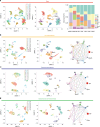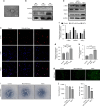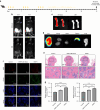M2 macrophages-derived exosomes for osteonecrosis of femoral head treatment: modulating neutrophil extracellular traps formation and endothelial phenotype transition
- PMID: 40169566
- PMCID: PMC11961764
- DOI: 10.1038/s41413-025-00412-5
M2 macrophages-derived exosomes for osteonecrosis of femoral head treatment: modulating neutrophil extracellular traps formation and endothelial phenotype transition
Abstract
Exosomes have shown good potential in ischemic injury disease treatments. However, evidence about their effect and molecular mechanisms in osteonecrosis of femoral head (ONFH) treatment is still limited. Here, we revealed the cell biology characters of ONFH osteonecrosis area bone tissue in single cell scale and thus identified a novel ONFH treatment approach based on M2 macrophages-derived exosomes (M2-Exos). We further show that M2-Exos are highly effective in the treatment of ONFH by modulating the phenotypes communication between neutrophil and endothelium including neutrophil extracellular traps formation and endothelial phenotype transition. Additionally, we identified that M2-Exos' therapeutic effect is attributed to the high content of miR-93-5p and constructed miR-93-5p overexpression model in vitro and in vivo based on lentivirus and adeno-associated virus respectively. Then we found miR-93-5p can not only reduce neutrophil extracellular traps formation but also improve angiogenic ability of endothelial cells. These results provided a new theoretical basis for the clinical application of ONFH therapeutic exosomes.
© 2025. The Author(s).
Conflict of interest statement
Competing interests: The authors declare no competing interests.
Figures






References
-
- Yoon, B. H. et al. The 2019 revised version of association research circulation osseous staging system of osteonecrosis of the femoral head. J. Arthroplast.35, 933–940 (2020). - PubMed
MeSH terms
Substances
Grants and funding
LinkOut - more resources
Full Text Sources

